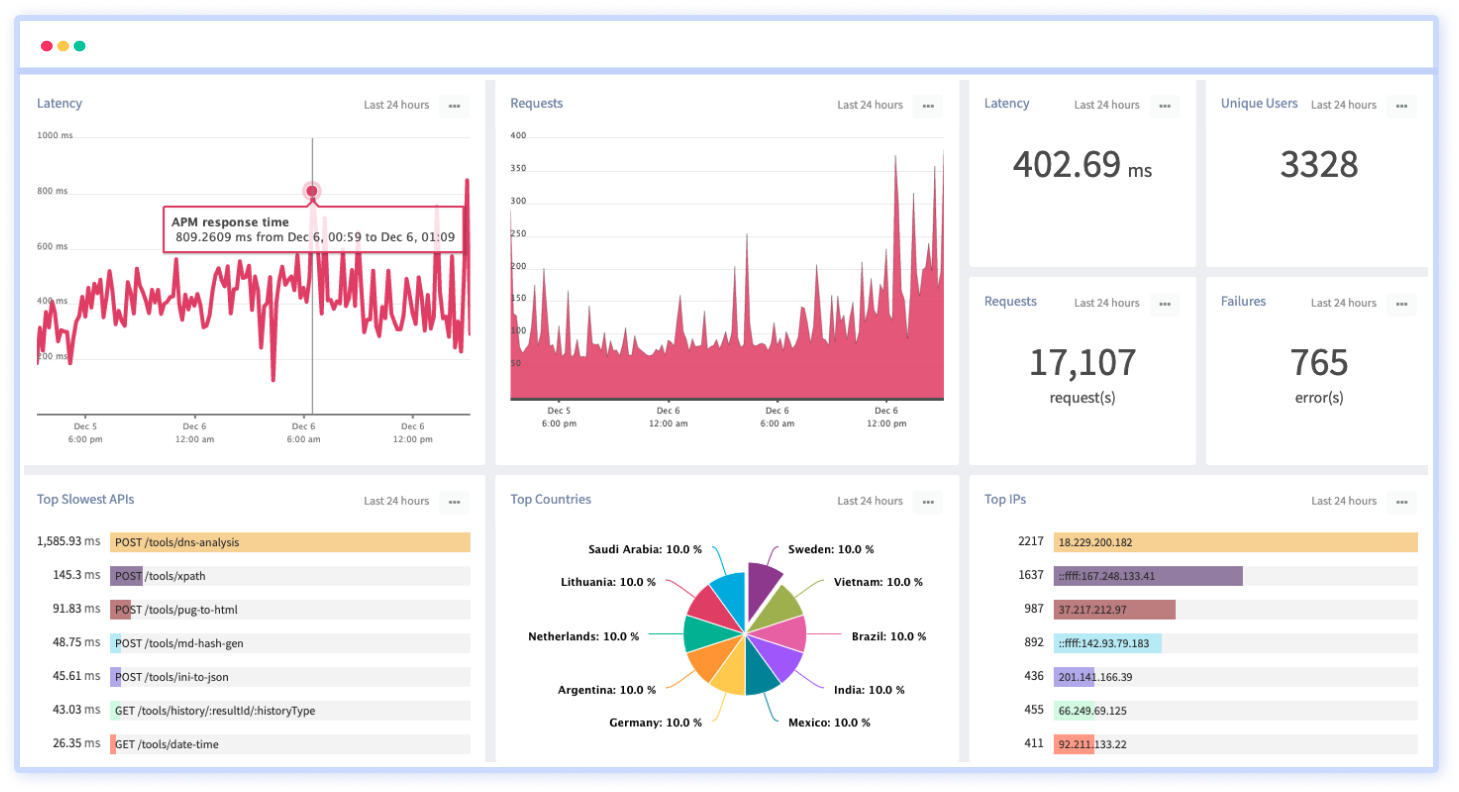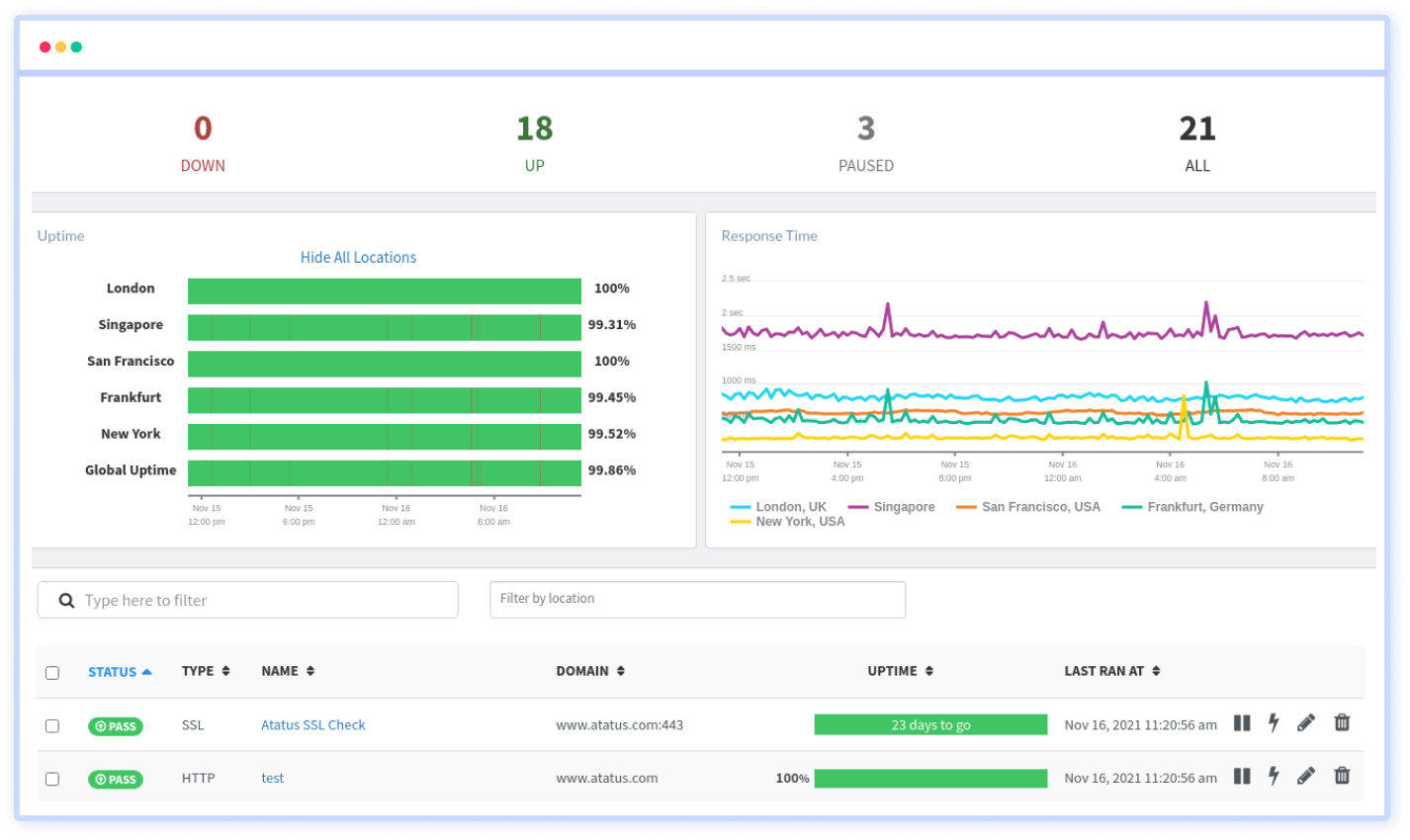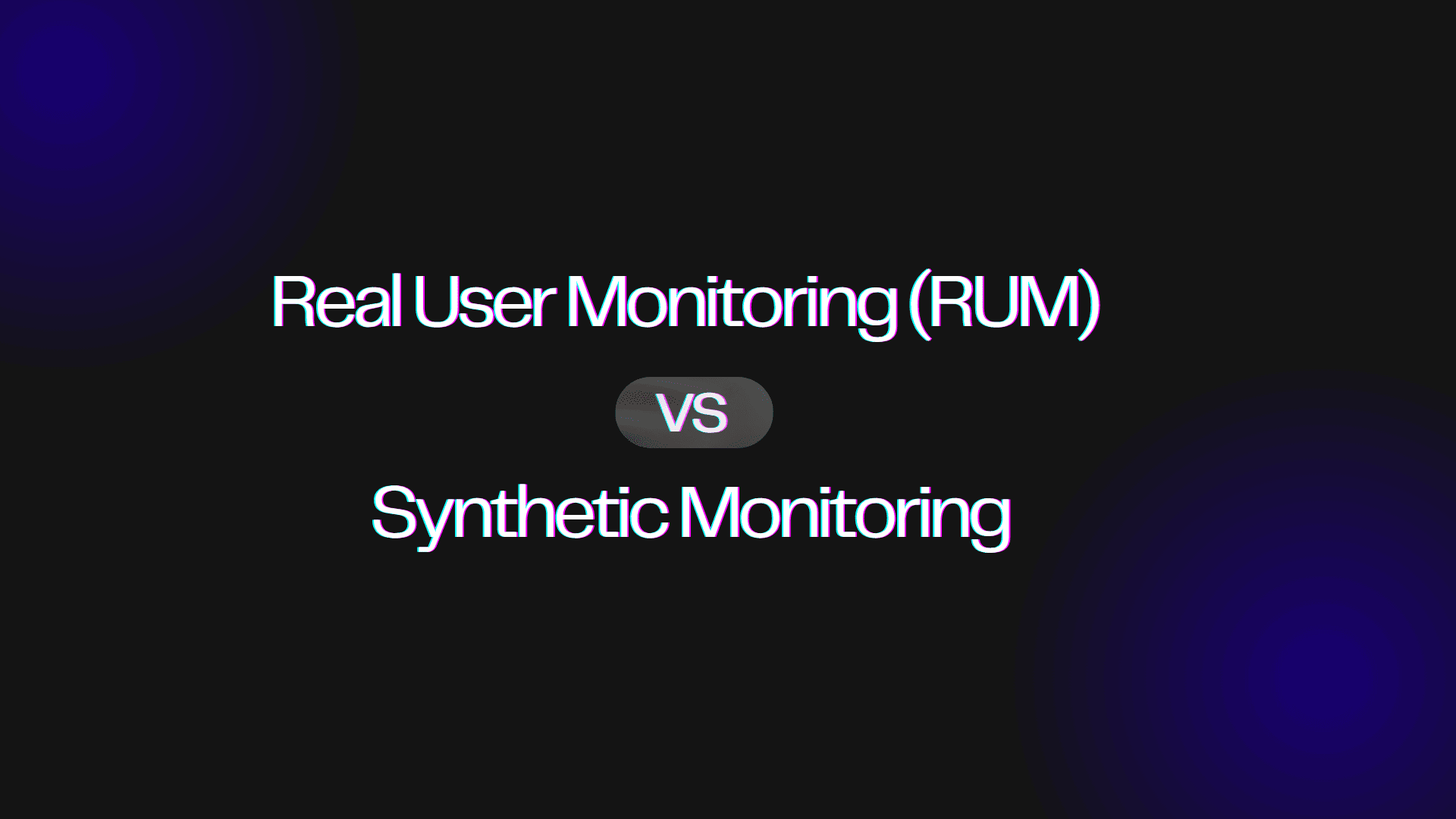What is Synthetic Monitoring?
No matter your business's sector or size, you probably depend on your websites, web applications, APIs, and complete IT infrastructure to be functional, available, and provide users with a pleasant experience.
However, we are aware that websites and applications cannot just be set up and left alone. Your websites, API, and applications could fail or experience significantly decreased performance for any period due to a variety of problems, including software bugs, hosting problems, third-party plugins, or worse yet, an attempt by hackers.
This would frustrate users and harm your company's bottom line. Are you regularly checking on these services to make sure they are operating as intended?
Fortunately, there are synthetic monitoring tools and solutions that can assist you in keeping track of your assets.
We will go over the following:
- What is Synthetic Monitoring?
- How Does Synthetic Monitoring Work?
- Types of Synthetic Monitoring
- Why do You Need Synthetic Monitoring?
- Challenges of Synthetic Monitoring
- Synthetic Monitoring vs RUM: What is the Difference?
- Do You Really Need Synthetic Monitoring?
#1 What is Synthetic Monitoring?
Synthetic monitoring is an active approach to evaluating a website or a website service for functionality, performance, and availability by mimicking visitor requests.
Synthetic monitoring is a broad phrase used to describe many different kinds of server and website monitoring systems. A network of checkpoints outside of the website's own servers from various locations throughout the network or world is used by synthetic monitors, which act like bots and connect to websites, web services, APIs, and servers to check on their availability, functionality, and performance.
In contrast to passive monitoring solutions (like Real User Monitoring), which require user activity to trigger the test, Synthetic Monitoring is thought of as an "active" or "proactive" method of testing that executes the test on a schedule.
During periods of low site traffic, an issue can go overlooked for a considerable amount of time with passive monitoring. Most people view Synthetic Monitoring as the first line of defense against outages and slowdowns due to its proactive approach to testing a website or service.

Synthetic monitoring is an application performance monitoring practice that imitates the actions users might take when interacting with them. It uses scripts to simulate user behavior for various scenarios, geographical regions, device types, and other variables.
Once this crucial performance data has been gathered and examined, a synthetic monitoring solution can:
- Give you important information about the performance of your application.
- Monitor application uptime automatically and inform you on how your application responds to normal user behavior.
- Focus on particular business transactions, such as by warning you of potential problems customers might have when attempting to complete a purchase or filling out a web form.
#2 How Does Synthetic Monitoring Work?🤔
To imitate what a normal user may do, synthetic monitoring works by sending automated, simulated transactions from a robot client to your application. To make sure that every computer in the data center is operating properly, synthetic monitoring can be used inside the firewall.

However, it can also be used outside the firewall to offer information on availability and performance on a global scale.
These server calls and testing scripts can be issued from a single designated synthetic monitoring client browser or multiple browsers at various server locations to better gauge site availability and responsiveness, globally.
Thus, even during times of low user interaction, you obtain a consistent, reliable baseline from which to measure the performance of servers and applications.
Additionally, because it is made up of test scripts that simulate an end-clickstream user during basic navigation, form submission, shopping cart transactions, or even online gaming, synthetic monitoring can be used to identify potential problems before the release of new features or during routine offline maintenance. The activity can either operate a real browser or imitate one.
Although simple and low-resource-intensive, browser simulation does not accurately reflect the user experience. Simulated browsers may not give realistic user experience data since they cannot follow dynamic, rich websites.
Synthetic tests offer a baseline and track your applications regardless of the hour or amount of website traffic, but they do not account for every activity that takes place there. Even if the tests pass, your end users might be experiencing problems.
This is because the tests don't accurately simulate the network, location, band with browser, or device, or because users are acting in ways on the website you aren't testing for. Synthetic testing is typically illustrative but not decisive of the user experience.
#3 Types of Synthetic Monitoring
There are many different sorts of synthetic monitoring that can assist you in achieving these advantages, but these are the main ones.

The most typical and maybe most fundamental sort of monitoring is uptime monitoring. It describes a website's overall accessibility and is typically expressed as a percentage. To put things into perspective, even with an excellent uptime availability of 99.999%, your website will have annual downtime of about 5 minutes.
The way uptime monitors operate is by making a simple request to the specified endpoint at predetermined intervals and reporting the response. This measure helps you determine whether users can access your website.
2) Web Performance Monitoring
Due to the abundance of options, your users want their preferred website or application to operate at its peak efficiency, therefore providing a service that falls short will hurt your company's bottom line. Website monitoring becomes important in this situation.
You can build intricate networks of monitors for all your resources and important website metrics using specialized website performance monitoring tools to make sure your users are getting the best possible experience.
Your website or application's performance depends heavily on both your internal and external APIs, thus it will be vital for your company to monitor APIs to make sure they are performing as planned.
You can find underperforming APIs using a synthetic monitoring strategy before they affect your users' experiences. It gives you all the information you require about the bottleneck, enabling you to quickly discover its cause.
Atatus provides Powerful API Observability to help you debug and prevent API issues. It monitors the consumer experience and be notified when abnormalities or issues arise. You can deeply understand who is using your APIs, how they are used, and the payloads they are sending.

Atatus's user-centric API observability tracks how your actual customers experience your APIs and applications. Customers may easily get metrics on their quota usage, SLAs, and more.
It monitors the functionality, availability, and performance data of your internal, external, and third-party APIs to see how your actual users interact with the API in your application. It also validates rest APIs and keeps track of metrics like latency, response time, and other performance indicators to ensure your application runs smoothly.
4) Synthetic Transaction Monitoring
A script that simulates a user's interaction with the website is typically used in synthetic transaction monitoring, a proactive website monitoring technique.
You can improve your strategy and use it as an early warning system to notify you when a step in the process is not going as planned by having a mechanism to simulate clicks and swipes.
In online stores and similar websites where users follow a typical path through and every deviation, delay, or error might result in their abandoning the purchase, transaction monitoring is particularly effective.
5) Browser Monitoring
To ensure you can provide the best user experience, browser monitoring is a technique used to simulate how different browsers would perform while loading your website and application.
You should make sure that all of the frameworks and third-party APIs used by websites and apps function flawlessly together regardless of the operating system or browser that your users are using.
We perform these tests using several machines located throughout the world and report back on load time, availability, and HTTP codes. If something goes wrong, you'll be alerted right away.
6) HTTP Monitoring
HTTP monitors will ping your website pages from various global checkpoints and report back on their accessibility. If you use more advanced tools, you'll also be able to put up complex HTTP requests and watch their response in addition to receiving information on load speed and HTTP status codes.
#4 Why do You Need Synthetic Monitoring?
By using synthetic monitoring, you can examine and evaluate your website and applications from the viewpoints of your end users. Furthermore, you'll be aware of where and when performance declines and any potential problems that can impair users' experiences.
Let's examine the benefits of employing synthetic performance monitoring in more detail.
- Resolve Performance Issues Before They Affect Your Users
By using synthetic monitoring, you can simulate user interactions and carry out a series of tests from various locations around the world. Regardless of whether there are actual users on the site, it will monitor all of your APIs, web and mobile applications, and web pages. Synthetic performance monitoring is used to identify problems before your users do. - Benchmark Your Website
Your synthetic monitoring tools can be configured to examine your APIs from various locations and at various times throughout the day. Utilize this information as a starting point for your benchmarks so that you can compare the quality of your service to that of your competitors and find any areas of the system that require improvement. - Test Your Ability to Scale
Your website and applications are made to respond rapidly to visitors, but when traffic unexpectedly increases, your server must be able to keep up. By using synthetic performance monitoring, you can create tests that simulate how your server would behave under stress. Once you have this information, you can plan the appropriate actions to ensure that your website and applications scale seamlessly. - Test Out New Features of Products
When you're launching new features, synthetic monitoring is a useful tool to have because it enables you to perform a full set of tests before making them live during peak hours. You'll be able to observe how the remainder of the application responds to load and determine whether any recent changes will affect any third-party APIs that you may use. - Track Important Business Processes and Third-Party APIs
It might be quite challenging to run your business without utilizing any third-party technologies but doing so exposes you to several issues linked to their availability. You must keep a tight check on them and be alert for any signs of slowing down. Monitoring API metrics alone, however, is insufficient to guarantee that you are giving your users a first-rate experience. Make sure your application's mission-critical elements, such as logging in, searching, and checkout, function as planned. - Ensure SLA Compliance
Regardless of whose side of the SLA you are on, it is crucial for both sides that the contract is being followed by everyone involved. If you are the service provider, you should employ synthetic monitoring techniques to ensure that you are aware of the performance constraints imposed by your application and that you have established reasonable goals. If you are the customer, you should confirm that the vendor can uphold his end of the bargain. - Reduce MTTR
By sending an alert to the appropriate person even before the problem starts affecting your users, synthetic monitoring software can help you significantly minimize your mean time to recovery (MTTR). You'll not only be informed of the problem earlier, but you'll also be able to replicate it and understand what's causing it.
#5 Challenges of Synthetic Monitoring
The complexity of modern applications is inherent. Synthetic monitoring is frequently insufficient to take into account all potential errors or scenarios because users access them from a range of locations and contexts.

DevOps teams are resolving this issue by giving priority to the adoption of application testing early in the software development life cycle. Even for the team members who have the necessary skill set, synthetic monitoring is nevertheless frequently challenging to correctly set up without specific technical knowledge and takes time.
Since synthetic tests aren't very robust, they frequently fail when minor UI changes are made, creating unneeded alarm noise. As a result, any time a small application component, like a button, is modified, the related test must also be altered.
Last but not least, a lot of synthetic monitoring tools lack the background information required to explain why a particular failure occurred or what the potential business implications might be, lengthening the time to resolution and making it unnecessarily challenging to prioritize application performance issues.
#6 Synthetic Monitoring vs RUM: What is the Difference?
Real user monitoring and synthetic monitoring are the two techniques used to monitor the performance of applications and websites.
Synthetic Monitoring, also known as synthetic transaction monitoring, employs several scripts to imitate user and server interactions while monitoring response times, response codes, etc.
Real User Monitoring (RUM), in contrast, is a passive kind of monitoring that observes interactions between the website and real users as opposed to simulating them. Every transaction and contact between the end user and server will be recorded by a little piece of JavaScript code that is put into the website.
In most cases, there is no practical reason why you should have to pick between real user monitoring and synthetic monitoring because both have advantages of their own.
Synthetic monitoring tools will let you know and understand what to expect in terms of user experience, but real user monitoring will show you exactly what happened. Real-user monitoring tools can show you long-term performance trends while synthetic monitoring tools can help track short-term issues.
RUM and Synthetic do address completely different issues when it comes to debugging, but many people combine the two because it guarantees the best possible application and website performance.
For instance, a problem that was discovered in RUM through user interaction might be further studied in Synthetics by keeping track of certain endpoints and services.
#7 Do You Really Need Synthetic Monitoring?
The user experience is given top emphasis in modern web applications and pages like single-page applications (SPAs). Applications and pages must be accessible around-the-clock, on any device, use on any size screen, secure, flexible, expandable, and able to handle traffic spikes as needed.
As a result, there are numerous chances and opportunities for errors to be made.

Technologies for websites and web applications have advanced significantly over time. Nowadays, websites do more than only store and retrieve data to deliver content to end users.
In the form of online forms, shopping carts, content management systems (CMS), online courses, etc., they now enable people to interact more with the business.
More than simple HTTP (Hypertext Transfer Protocol) monitoring is needed for these modern web applications and websites. To attract new customers and grow their business, they must offer a pleasurable experience.
You can make sure that the user experience, content, and aspects are all intact and working effectively by putting the right monitoring strategy into place. For all of your complicated applications and websites, the ideal synthetic monitoring solution can provide you with the technology and tools you need to deliver an exceptional user experience.
For a company whose primary revenue streams come from its websites and applications, having exceptional uptime and performance around-the-clock is very important—some may even say essential. Users who depend on your websites, programs, and APIs for enjoyment or basic necessities won't put up with even a short delay.
Performance issues with web applications and pages must be actively detected and diagnosed. Synthetic monitoring can take place at various global checkpoints and at various frequencies to ensure that you are consistently giving your users the greatest experience possible.
Conclusion
A brand can use Synthetic Monitoring to proactively monitor web and network assets and receive notifications when something goes wrong. A brand should think about synthetic monitoring as its first line of defense to safeguard availability, performance, and function because of the flexibility it provides.
Monitor your website using Atatus Synthetic Monitoring
Atatus Synthetic Monitoring ensures uptime, identifies regional issues, tracks application performance, and manages SLAs and SLOs by monitoring your applications, API endpoints, and critical business flows via simulated user requests.

Atatus monitors the performance of your webpages and APIs in a regulated and steady manner, from the backend to the frontend, and at multiple network levels, warning you in the event of erroneous behavior such as regression, broken feature, high response time, unexpected status code, and so on.
#1 Solution for Logs, Traces & Metrics
APM
Kubernetes
Logs
Synthetics
RUM
Serverless
Security
More





